Many psychologists contend that nagging is counterproductive. Fortunately, that wasn’t the case with Kawasaki, as the flood of e-mails requesting that it bring its Versys 650 stateside worked. The Versys was introduced last year to the European and Canadian markets, and a company spokesman told us that U.S. enthusiasts were so relentless Kawasaki finally broke down and brought it here. So now that we have it, what do we call it? Is it a sportbike? Is it an adventure tourer? Perhaps it’s a practical commuter? Kawasaki appears to be unsure as well, since it categorizes the Versys as a “Jack of all trades.” It finally came up with the Versys name by combining parts of the words “versatility” and “system.”
Call it what you want; we say the Versys is one of the most fun and versatile motorcycles we’ve ridden, as it just plain works well in so many ways. The liquid- cooled, 649cc, DOHC parallel twin with four valves per cylinder is based on the Kawasaki Ninja 650R that was introduced in 2006. Kawasaki retuned the Versys’ engine for better low- to midrange response by revising the camshafts and adding a connector between the header pipes. The radiator’s cooling capacity has also been increased by 12 percent. In use the Versys’ compact engine has a sense of urgency to it, and though it makes less peak horsepower than the Ninja, power delivery is more linear and I like the Versys better. The engine has good low- and midrange torque with lots of power in the lower rev range where most riding is done. Shifting through the six-speed cassette-style gearbox is a smooooth affair, too. Finding neutral at stops requires just a flick of your foot, though sometimes it is difficult to locate neutral when you start the engine again after parking the bike in gear.
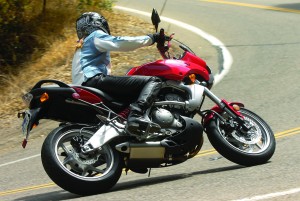
The Versys utilizes a digital fuel-injection system with two 38mm Keihin throttle bodies that have ECU-controlled sub throttle valves. The latter give the fuel-injection system more precise throttle response. An automatic fast-idle system makes start-up easy, though we notice that if we start up the bike and take off right away, there’s a little bit of roughness at idle until the bike fully warms up. When you twist the throttle, though, power is right there–instantaneous and smooth. This is very apparent when you’re maneuvering through traffic, on and off the throttle, and when diving into turns on twisty roads.
Kawasaki calls the Versys’ lightweight, unequal-sided swingarm a gull-wing design (and it’s quite a topic for discussion when you pull up somewhere). It’s probably shaped that way to clear the exhaust, which is tucked underneath the engine…or perhaps the exhaust was designed to clear the gull-wing! The inconspicuous exhaust and offset, laydown single shock are two reasons why the Versys has such a clean look to it.
Curving roads are the Versys’ forte. It’s quick and agile in the twisties, where you can get going at a good clip. Long-travel suspension gives it a generous amount of cornering clearance, and it takes just a light touch to steer through the curves, with good low-end torque to power it strongly through uphill turns. With rake and trail figures at 25 degrees and 4.3 inches the Versys flows smoothly through the curves and feels stable at highway speed, too.
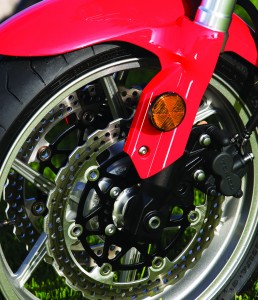
Up front the 41mm inverted fork has adjustments for height in the triple clamps, spring preload and rebound damping (the latter atop one fork leg only). Kawasaki says that it used stiff springs that combine the best of off-road and sportbike-type suspension. We didn’t need to mess with it much and found that the front suspension tracks well under a variety of conditions. Out back is a Showa shock with seven-position adjustable spring preload and adjustable rebound damping with 5.7 inches of travel. The shock uses a free piston and two-stage damping valves for smooth action during initial compression that becomes firmer near the end of the stroke, resulting in a more planted feel. We left it set the way the bike was delivered, on the number 5 spring preload detent and middle damping position, and liked it fine for most riding. Despite its hybrid suspension and ground clearance, the Versys wasn’t really designed for offroad riding, so we didn’t take it there. On the highway the suspension feels a bit too stiff in back even on lower preload settings, but soaks up pavement irregularities elsewhere without bouncing you out of the seat. It’s especially compliant as you run through the twisties, where the rear suspension stays fluid when changing direction.
Feel from the dual petal disc brakes with two-piston calipers in front is a little wooden, like they could use more bite, and the single petal disc with single-piston caliper in the rear could use more strength as well. It’s more an issue of feel than actual stopping power, which is still quite satisfactory.
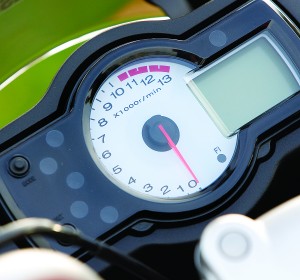
The engine is very smooth and what little vibration reaches the rider is not bothersome. Stalk-mounted mirrors shake a bit but overall give a good, wide rear view. Hop aboard the lofty Versys and you’re instantly comfortable. Our riders, ranging in height from 5 feet, 7 inches, to 6 feet, 4 inches, were generally pleased with the ergonomics. Most of us could tuck our legs right in to fit around the lower part of the tank. There’s no fairing to knock your knees into or to harbor engine heat so heat’s whisked away, keeping your legs from cooking. Arms are placed in a natural position and you’re sitting upright–no uptight shoulders or tweaked necks here even after lots of miles. The handlebar offers good leverage, so you feel connected to the bike, as if you can steer through any situation.
The 33.1-inch-high seat will be too lofty for many riders but tapers in front, making it easier to get your feet down at stops. Our staff’s newbie rider, at 5 feet, 7 inches, looked at the tall, lean Versys with skepticism. We convinced her she should give it a try and once underway, she felt confident because of the Versys’ user-friendliness and lightweight, compact feel. There’s not a lot of room to reposition your rear on the split-level seat, but overall the seat’s comfortable, though you will need a break from the thin foam padding before the end of a long riding day. We tried the passenger accommodations on a brief ride and found the footpeg position and seat just fine, with no exhaust in hot proximity and good grab handles. The passenger seat does position the copilot way higher than the rider, so he or she gets quite a bit of windblast.
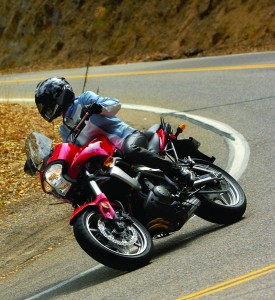
The Versys can bring out the inner child, as it’s quick and easy to ride and something of a wheelie machine for those so inclined. One touring rider who sampled the Versys described it as “A bike I wouldn’t change, though I’d have it as a second bike for day rides, as it’s too sporty for me as an only motorcycle. But wow, it is fun!” Despite carrying its weight up high, the Versys is also easy to maneuver at slow speeds. It helps that it weighs just 454 pounds fully fueled.
The bike’s small adjustable windscreen has three settings. Just remove the four bolts and you can move it in 20mm increments. Our windscreen was set at the highest point and did a good job deflecting windblast over my helmet and chest without much buffeting. I notice more air coming up from below and being channeled around, so my neck gets a breeze, but the small ‘screen remains below my line of sight.
The Versys radiates fun while being rider friendly, easy to handle and having lots of useable power. It thrives on back roads and twisty roads, maneuvering around town and through traffic, yet is all-day comfortable. It excels in so many ways that it’ll appeal to a wide–and tall–variety of riders.
Now that we’ve driven Kawasaki nuts with our pleas to bring the Versys here, it remains to be seen how well it will sell. The last-minute decision to bring it to the States will keep the Versys from being available in California for 2008 due to a lack of emissions compliance–there just wasn’t time to tool up a gas tank and frame mounts for an evaporative emissions canister–but if demand is strong enough perhaps Kawasaki can get it ready for a Golden State debut in 2009. Fire off those e-mails; it’s worked before.
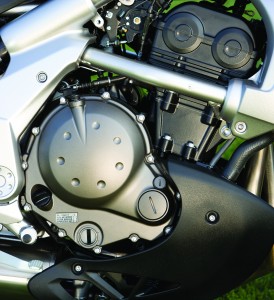








great bikes i bought a 2008 new and rode it 9 years put 40k miles on it never had a issue. light weight with good power and 60 mpg
Bought a used 2008 Kawasaki Versy 650 in December of 2024 with about 28,000 miles. It’s everything and more than your Rider evaluation. Even after all these years it remains a fun bike to ride.